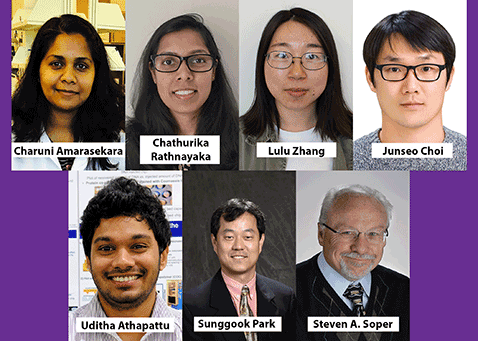New Papers Accepted for CBM2 Researchers
CBM2 researchers from the University of Kansas and Louisiana State University have two new papers accepted for publication in January 2021.

The first paper, published online January 8, 2021 in the Journal of Chromatography A, is titled, “Electrokinetic Identification of Ribonucleotide Monophosphates (rNMPs) using Thermoplastic Nanochannels.” Authors of the paper are Charuni A. Amarasekara, Chathurika Rathnayaka, Uditha S. Athapattu, Lulu Zhang, Junseo Choi, Sunggook Park, Aaron Nagel, and Steven A. Soper. In it, the authors describe that they were able to efficiently identify rNMPs more than 99% of the time using their plastic nanofluidic devices with 110 x 110 nm (width x depth) and 100 μm length channels in a process called nanoscale electrophoresis, by which molecules of different sizes are separated during migration through the channel. These nano-sized channels can be made in thermoplastic materials using Nanoimprint Lithography (NIL) to produce nanofluidic devices in plastics at a much higher rate and lower cost compared to glass-based nanofluidic devices. The researchers are currently working on making the nanofluidic devices using a nano-injection molding machine to make the devices even more cost-effective and to increase their production rate. Through the high identification efficiency of nanoscale electrophoresis, the group is developing a new single-molecule RNA sequencing strategy.
The second paper accepted for publication in January 2021 is titled, “Solid-Phase XRN1 Reactions for RNA Cleavage: Application in Single-Molecule Sequencing,” and was accepted to the journal Nucleic Acids Research. Authors of this paper are Uditha S. Athapattu, Charuni A. Amarasekara, Jacob R. Immel, Steven Bloom, Francis Barany, Aaron C. Nagel, and Steven A. Soper. RNA sequencing is important for detection of SARS-CoV-2 coronavirus, as well as vaccine discovery and determining resistance. The authors’ new single-molecule sequencing strategy described in this paper could make testing for coronavirus faster, simpler, and less expensive, and in some cases eliminate the need for amplification through PCR. In this study, the researchers attached XRN1 enzyme to the solid pillars inside the channels of the plastic testing device which will digest the RNA present in the sample fluid (saliva, blood, etc.) loaded onto the testing device. The use of XRN1 enzyme to digest the RNA could eliminate the need for antibodies and bisulfide treatment used in current next generation sequencing methods, which would make sequencing the RNA of patient samples faster and cheaper.